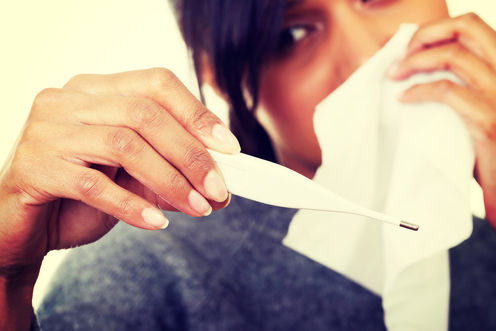
It’s that time of year again when scientists and doctors make predictions about the impending influenza (flu) season and we must decide whether to go out and get the flu vaccine.
The government-funded flu vaccine will be available from 20 April, a month later than most years, as the vaccine has been reformulated to cover a new strain. But some GPs may offer the vaccine privately before then.
So, who should consider getting the vaccine and who gets it for free? And are we really in for a bad flu season in Australia?
How does the vaccine work?
The flu vaccine helps prevent us from getting the flu each season. It contains dead, broken-up bits of flu viruses that are expected to circulate during the upcoming season.
Once injected into our arms, the pieces of dead virus stimulate our body’s immune response to produce antibodies, which act as a defence that can rapidly swing into action when a live flu virus infects our nose and throat.
Because the viruses in the vaccine are dead, they can’t give us flu.
What’s new about flu vaccines in 2015?
For the first time, Indigenous children are able to access free flu vaccine in Australia.
This is important because Aboriginal and Torres Strait Islander children are five times more likely to be hospitalised with flu and pneumonia than non-Indigenous children. Indigenous children are also 17 times more likely to die from flu or pneumonia than non-Indigenous children.

This year a new flu vaccine, known as “quadrivalent”, will be available. This type of vaccine contains four flu viruses compared with three in the normal trivalent vaccine. The additional flu strain provides extra insurance that may be useful if unexpected viruses begin to circulate.
However, it’s likely that the standard trivalent vaccine will cover the great majority of the flu A and B strains expected to circulate in Australia this winter.
The quadrivalent vaccine won’t be available via the government’s free flu vaccine program and will be more expensive than the standard trivalent vaccine if purchasing it privately.
Who should get the flu vaccine?
For certain members of the community, catching flu can lead to severe illness or death. It is these “high-risk” groups (listed below) that should actively avoid catching it. Getting the flu vaccine is a major step towards achieving protection from flu.
Certain groups of individuals at high risk of developing severe illness or complications if infected with flu are eligible for free flu vaccine via the federal government. These are:
-
Anyone aged 65 years or over
-
Aboriginal and Torres Strait Islander people aged 15 years or over
-
Aboriginal and Torres Strait Islander children aged between six months and five years
-
Pregnant women
-
Anyone with with medical conditions that can lead to severe influenza, including people with heart disease, severe asthma and diabetes. A full list of eligible medical conditions can be found here.
Within the over-65 age group, a high proportion of people are vaccinated (more than 70%).
But although the flu vaccine is provided free of charge to vulnerable people, many still don’t get it. Less than 30% of pregnant women and Indigenous people receive the flu vaccine. Only half of those with medical conditions that can lead to severe influenza get vaccinated.

Although not included in the government’s free flu vaccine program, children under the age of two years are also highly susceptible to flu.
Once infected with flu, young kids are more likely to be hospitalised with severe illness than those in the over 65 age group. About half of young children who die from the flu are otherwise healthy with no underlying medical conditions or known risk factors.
Most children who die from flu are not vaccinated. Therefore the idea that fit, healthy infants can simply “fight off” a flu infection without any problem is not always true.
Another benefit of preventing flu in children is that it reduces the spread of infections to other vulnerable family members such as grandparents.
What’s in store for us this winter?
The one predictable thing about flu, is that it is unpredictable! However, we often look to the northern hemipshere’s winter flu season to give some insights into what might be expected here.
The recent flu season in the United States and most of Europe was dominated by the A(H3N2) strain of flu. This virus has historically been associated with increased severity in the elderly.
There has been a lot of media coverage about bad vaccine match in the northern hemisphere. This is because most of the serious influenza was caused by the A(H3N2) viruses which had changed over the five to six months when the vaccine producers were manufacturing the vaccine. But the other components of the vaccine were well matched.
Our vaccine has been updated to protect Australians against the new A(H3N2) viruses.
So, if you or a loved one fall within the high-risk groups described above, getting the vaccine remains the most effective way to avoid the inconvenience and potentially severe health risks of the flu – and passing it on.
Aeron Hurt is a Senior Scientist at the WHO Collaborating Centre for Reference and Research on Influenza, VIDRL based at the Peter Doherty Institute, Parkville, Melbourne. Aeron is also an honorary Principal Fellow at the University of Melbourne within the Melbourne School of Population and Global Healths The Melbourne WHO Collaborating Centre for Reference and Research on Influenza is supported by the Australian Government Department of Health and also receives funding from the IFPMA (International Federation of Pharmaceutical Manufacturers & Associations) and Novartis Vaccines under cooperative research agreements. AH holds shares in CSL Limited, a manufacturer of influenza vaccines.
